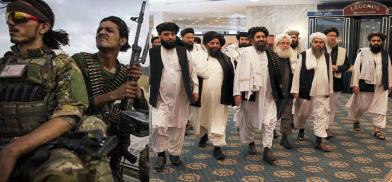For a political settlement in Afghanistan, Taliban's perception of military takeover needs to be broken
Although the Taliban has captured at least 33 district centers in the last two months, they have no capacity, manpower, and resources to run big cities. They had tried in the past and failed miserably, writes Shraddha Nand Bhatnagar for South Asia Monitor

Sixteen months after the signing of “the agreement to bring peace in Afghanistan” (Doha Agreement) in Qatar, there is no sign of any potential political settlement among Afghan parties soon, let alone peace. The US troops are on their way out; the Taliban has not yet started negotiating in good faith; and, the war has already intensified, leaving little doubt what had been negotiated in Doha was indeed a bad deal.
Having forced foreign troops out of the country unconditionally, the Taliban, at this stage, looks pretty confident of gaining a military victory over the Afghan government. The US decision to disengage itself militarily from the Afghan conflict might be seen as the loss of interest to the world, whereas the Taliban, and its rank and file, perceive it as their victory.
The group’s military wings, one of the most powerful commissions in the group, are unlikely to cede any space for genuine political negotiations to the Afghanistan government, which they consider a secondary adversary to their bigger enemy, America.
Peace not on horizon
“The issue of peace, at least in the immediate future or roughly within the next year, isn’t possible,” Arian Sharifi, senior foreign policy advisor to the Afghan foreign minister and former director of the National Threat Assessment of NSC Kabul, said in a recent webinar titled 'Afghanistan Post US Withdrawal, organized by the India International Centre, New Delhi. He claimed that the insurgent group had this perception of advantage in the war.
Importantly, for any warring party, to reach a peace agreement, it is important to create a peace constituency within the organization. “The Taliban haven’t positioned themselves either for a sustainable, or temporary, ceasefire,” opined Vishal Chandra, Research Fellow, Manohar Parrikar Institute for Defense Studies and Analysis, New Delhi.
“For the Taliban, it won’t be easy to sell any peace agreement--or the idea of sharing power--with the forces it has been fighting against for two decades now,” he added. Violence, for them, isn’t just a means to gain power, he submitted, adding it also helped them to keep their cadre engaged.
A ceasefire, therefore, might prove detrimental to the Taliban organizationally.
The Pakistani dimension
External dimensions to the Afghan war are as important as the internal dimensions. There is a consensus on no return to the Taliban’s emirate era. The region is divided on the terms of peace nonetheless. However, it remains to be seen how Iran, which has aided the Taliban tactically because of the US presence, positions itself in the post-American withdrawal.
The relationship between the Taliban and Pakistan remains a hotly debated topic. Some experts say the Taliban takes orders from Pakistan where they have their sanctuaries. Others contest the belief.
“The relationship is there, a very old, but it’s not very friendly. Pakistan can’t push the Taliban,” Rahimullah Yusufzai, Resident Editor of the News International newspaper in Pakistan and a long-time watcher of jihadi forces in the region, said.
Highlighting the difference between the 90s and today, he said, “Pakistan was a more powerful kingmaker in the past when America and other countries were on the side of Pakistan.” Its relationship with the US has deteriorated since then, and the Taliban, on the other hand, expanded its diplomatic outreach to many countries.
Sixty percent of members of the Rahbari Shura, the highest executive body of the Taliban, live in Doha now.
Despite the troubled relationship, Yousufzai believes, Pakistan would continue supporting the Taliban for at least a year just to see how they fare. Though, he added, a full return of the Taliban would not go in Pakistan's favor.
Can the center hold?
Lately, there are growing apprehensions if the Afghan government would be able to hold ground for the next year or beyond as the Taliban has been expanding its presence. On the other hand, the Taliban also seems to be testing waters, for at least the immediate future, to see how far they can go with the military option.
“It is important to continue the war against the Taliban if they're not willing to come to peace in good faith until such a point that they actually realize that even without the presence of NATO and US forces they can’t get military victory over the Afghan government,” Sharifi said. “And, then there would be a point when The Taliban would potentially be amenable to agreeing to a peace agreement,” he added.
Although the Taliban has captured at least 33 district centers in the last two months, they have no capacity, manpower, and resources to run big cities. They had tried in the past and failed miserably.
Whether there would be a political settlement or not will depend a lot on the survival of the Afghan government, both politically and militarily. Conditions for peace would be more conducive if the Afghan government manages to keep the conflict stalemated -- by holding major population centers, provincial capitals, and main highways for at least a year or beyond.
The stalemated situation, then, may push a change in the Taliban’s calculations that there is more to gain from a political settlement than from continuomg the war. However, for this to happen, the Taliban’s perception of gaining a military victory needs to be broken.
(The writer is a Research Associate, Society for Policy Studies (SPS), The views expressed are personal. He can be contacted at snbhatnagar296@gmail.com)









Post a Comment